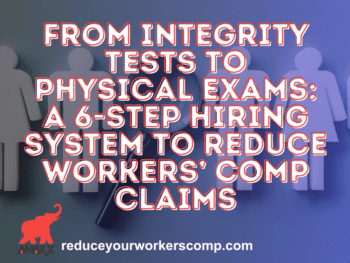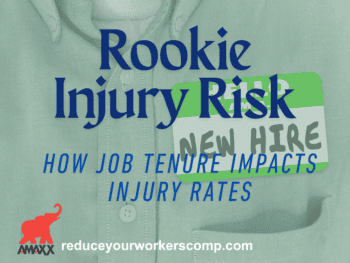
Imagine you knew that an injured worker had a pre-existing impairment.
Having access to that information could substantially reduce workers’ compensation costs related to the claim.
The employee would still be able to get the benefits he/she is entitled to, but the employer wouldn’t be paying unnecessarily for a condition the employee had prior to working for the company.
10 percent of Americans between the age of 18 and 65 have some type of physical limitation that could potentially impact their ability to safely perform the essential physical demands of the job. That means one out of every 10 people in an organization came to the job already impaired and could be at risk for injury. Unfortunately, many companies have no idea if or what pre-existing conditions employees have. Absent a pre-employment post-offer test, they end up paying for them once the worker experiences an injury.
Click Link to Access Free PDF Download
“4-Step Sequence For Effective Employee Screening, Hiring, & Placement”
Post-offer, functional employment testing provides the ability to establish baseline health information and the physical stability of all employees pre-hire. The assessment also allows the employer to determine the degree of any pre-existing conditions and;
- whether it will impact their ability to safely perform the essential physical demands associate with their job,
- whether placement into the position could put the candidate at direct threat of imminent harm,
- provide valuable, objective information that can used in interactive dialogue,
- utilize the information for goal setting in rehabilitation and work conditioning,
- use that information in an apportionment process when allowed under state workers compensation law
Gathering baseline information as part of pre-employment post-offer assessment is a win-win for employers, employees, and the healthcare clinicians providing rehabilitation services. This type of an objective, individualized assessment helps employers make placement decisions to ensure workplace safety and provides for the ongoing occupational health management of employees.
Pre-Employment Testing
The Americans with Disabilities Act and the subsequent amended act of 2008 allows employers to medically and physically evaluate their workers at all stages of employment. This fact is extremely valuable, in that this type of assessment can help employers determine whether a job candidate can fulfill the physical requirements of the job, if he needs some type of accommodation, or whether placement into a different position is more appropriate to keep him safe from harm.
After a candidate has been interviewed and a bona fide offer of employment has been extended, various contingency processes such as background checks, drug testing, and pre-employment testing can be administered. That is, the job is conditioned upon the applicant demonstrating performing he can physically perform the required job tasks.
This test is not the same as a routine physical. These tests usually occur in physical therapy or occupational medical clinics certified as part of a national vendor that licenses clinics throughout the U.S. A clinician collects various medical information, such as:
- Medical history review including past work-related injuries
- A series of comprehensive medical measurements to document pre-existing impairments
- Strength measures
- Dynamic lifting & progressive lifting sequence
- Cardiovascular measures
- Job-specific testing demonstrating the capability to safely perform the essential functions of the job
The medical information gathered during the process is kept for future reference in the event an injury occurs. A physician would then be able to determine any change in condition and offer recommendations for rehabilitation, if needed.
Baseline Info for WC
The workers’ compensation system assumes that workers are perfect when they are initially hired and that any injury they incur was caused on the job. This is where the baseline, pre-employment testing comes into play. The organization already has information about the worker’s baseline health when he was hired. That information can often reveal that only some of the employee’s injury was caused by his present work, and, thus, save valuable dollars.
For example, the post-offer pre-employment test may have identified that a worker has a 10 percent shoulder impairment. If she later has an injury to that same shoulder and is deemed to have a 12 percent impairment, the employer would be responsible only for the 2 percent additional impairment.
In another example, suppose the pre-employment testing showed the applicant has a pre-existing 20 percent loss of strength and motion to his right shoulder, but despite this impairment, he is able to lift 70 lbs. from the ground, 40 lbs. overhead, and perform other tasks the job requires. If a subsequent work injury results in a 25 percent loss of shoulder strength and motion, it would mean the extent of the actual work injury was minor — only a 5 percent difference from when he was hired. This worker would likely need only care such as ice, massage, and taping before being able to return to his job. Without knowing his baseline health, the worker would likely have to undergo medical diagnosis and treatment that was expensive — and unnecessary.
Conclusion
Organizations don’t want to hire their next workers’ compensation claim. Nor do they want to pay unnecessarily for physical maladies that were not caused at their worksites. Post-offer pre-employment testing that adheres to all legal requirements can effectively address both these issues.

Author Michael Stack, CEO Amaxx LLC. He is an expert in workers’ compensation cost containment systems and helps employers reduce their workers’ comp costs by 20% to 50%. He works as a consultant to large and mid-market clients, is a co-author of Your Ultimate Guide To Mastering Workers Comp Costs, a comprehensive step-by-step manual of cost containment strategies based on hands-on field experience, and is founder & lead trainer of Amaxx Workers’ Comp Training Center.
Contact: mstack@reduceyourworkerscomp.com.
Workers’ Comp Roundup Blog: https://blog.reduceyourworkerscomp.com/
©2020 Amaxx LLC. All rights reserved under International Copyright Law.
Do not use this information without independent verification. All state laws vary. You should consult with your insurance broker, attorney, or qualified professional.

















